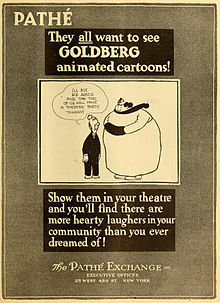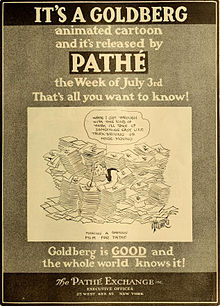This is an old revision of this page, as edited by DVdm (talk | contribs) at 16:03, 1 October 2014 (Reverted edits by 72.10.123.177 (talk): nonconstructive edits (HG)). The present address (URL) is a permanent link to this revision, which may differ significantly from the current revision.
Revision as of 16:03, 1 October 2014 by DVdm (talk | contribs) (Reverted edits by 72.10.123.177 (talk): nonconstructive edits (HG))(diff) ← Previous revision | Latest revision (diff) | Newer revision → (diff) For the namesake contraption, see Rube Goldberg machine.
| Rube Goldberg | |
|---|---|
 In 1916 In 1916 | |
| Born | Reuben Garrett Lucius Goldberg (1883-07-04)July 4, 1883 San Francisco, California, U.S. |
| Died | December 7, 1970(1970-12-07) (aged 87) New York City, New York, U.S. |
| Resting place | Mount Pleasant Cemetery in Hawthorne, New York |
| Occupation(s) | Engineer, sculptor, news reporter, cartoonist |
| Known for | Rube Goldberg machines |
Reuben Garrett Lucius "Rube" Goldberg (July 4, 1883 – December 7, 1970) was an American cartoonist, sculptor, author, engineer, and inventor.
He is best known for a series of popular cartoons depicting complicated gadgets that perform simple tasks in indirect, convoluted ways, similar to Heath Robinson devices in the UK, as well as the Storm P devices in Denmark. Goldberg received many honors in his lifetime, including a Pulitzer Prize for his political cartooning in 1948 and the Banshees' Silver Lady Award 1959.
Goldberg was a founding member and the first president of the National Cartoonists Society, and he is the namesake of the Reuben Award, which the organization awards to the Cartoonist of the Year. He is the inspiration for various international competitions, known as Rube Goldberg Machine Contests, which challenge participants to make a complicated machine to perform a simple task.
Personal life
Reuben Lucius Goldberg was born July 4, 1883, in San Francisco, California, to Jewish parents Max and Hannah (Cohen) Goldberg. He was the third of seven children, three of whom died as children (older brother Garrett, younger brother Walter, and younger sister Lillian also survived).
Rube began tracing illustrations when he was four years old, and first took professional drawing lessons when he was eleven.
Rube married Irma Seeman on October 17, 1916. They lived at 98 Central Park West in New York City and had two sons named Thomas and George.
Goldberg did not share a surname with his children because of the amount of hatred towards him during World War II stemming from the political nature of his cartoons. He ordered his sons to change their names from Goldberg for safety reasons. Both of his sons chose the last name of George, wanting to keep a sense of family cohesiveness. Thomas and George's children now run a company called RGI (Rube Goldberg Incorporated) to maintain the Goldberg name. John George (Thomas's son) is assisted by his cousin Jennifer George (George's daughter) and John's son Joshua George to keep the family name alive.
Goldberg died in 1970 at the age of 87, while his widow, Irma, died on April 26, 1990 at the age of 95.
Career

Goldberg's father was a San Francisco police and fire commissioner, who encouraged the young Reuben to pursue a career in engineering. Rube graduated from the University of California, Berkeley in 1904 with a degree in Engineering and was hired by the city of San Francisco as an engineer for the Water and Sewers Department. After six months he resigned his position with the city to join the San Francisco Chronicle where he became a sports cartoonist. The following year, he took a job with the San Francisco Bulletin, where he remained until he moved to New York City in 1907.
Goldberg drew cartoons for five newspapers, including the New York Journal American|New York Evening Journal and the New York Evening Mail. His work entered syndication in 1915, beginning his nationwide popularity. He was syndicated by the McNaught Syndicate from 1922 until 1934.
A prolific artist, Goldberg produced several cartoon series simultaneously, including Mike and Ike (They Look Alike), Boob McNutt, Foolish Questions, "Lala Palooza" and The Weekly Meeting of the Tuesday Women's Club. The cartoons that brought him lasting fame involved a character named Professor Lucifer Gorgonzola Butts. In that series, Goldberg drew labeled schematics of the comical "inventions" that would later bear his name.
Cultural legacy
In 1931 the Merriam-Webster dictionary adopted the word "Rube Goldberg" as an adjective defined as accomplishing something simple through complicated means.
Predating Goldberg, the corresponding term in the UK was, and still is, "Heath Robinson", after the English illustrator with an equal devotion to odd machinery, also portraying sequential or chain reaction elements.
Goldberg's work was commemorated posthumously in 1995 with the inclusion of Rube Goldberg's Inventions, depicting Professor Butts' "Self-Operating Napkin" in the Comic Strip Classics series of U.S. postage stamps.
Film and television


Rube Goldberg wrote a feature film featuring his machines and sculptures called Soup to Nuts, which was released in 1930 and starred Ted Healy and The Three Stooges.
In the 1962 John Wayne movie Hatari!, an invention to catch monkeys by character Pockets, played by Red Buttons, is described as a "Rube Goldberg."
In the late 1960s and early 70s, educational shows like Sesame Street, Vision On and The Electric Company routinely showed bits that involved Rube Goldberg devices, including the Rube Goldberg Alphabet Contraption, and the What Happens Next Machine.
Various other films and cartoons have included highly complicated machines that perform simple tasks. Among these are Flåklypa Grand Prix, Looney Tunes, Tom and Jerry, Wallace and Gromit, Pee-wee's Big Adventure, The Way Things Go, Edward Scissorhands, Back to the Future, Honey, I Shrunk the Kids, The Goonies, Gremlins, the Saw film series, Chitty Chitty Bang Bang, The Cat from Outer Space, Malcolm, Family Guy, American Dad!, and Waiting...
Also in the Final Destination film series the characters often die in Rube Goldberg-esque ways. In the film The Great Mouse Detective, the villain Ratigan attempts to kill the film's heroes, Basil of Baker Street and David Q. Dawson, with a Rube Goldberg style device. The classic video in this genre was done by the artist duo Peter Fischli & David Weiss in 1987 with their 30 minute video "Der Lauf der Dinge" or "The Way Things Go".
Honda produced a video in 2003 called "The Cog" using many of the same principles that Fischli and Weiss had done in 1987.
In 2005, the American alternative rock/indie band The Bravery released a video for their debut single, "An Honest Mistake," which features the band performing the song in the middle of a Rube Goldberg machine.
In 1999, an episode of The X-Files was titled "The Goldberg Variation". The episode intertwined characters FBI agents Mulder and Scully, a simple apartment super, Henry Weems (Willie Garson) and an ailing young boy, Ritchie Lupone (Shia LaBeouf) in a real-life Goldberg device.
The 2010 music video "This Too Shall Pass – RGM Version" by the rock band OK Go features a machine that, after four minutes of kinetic activity, shoots the band members in the face with paint. "RGM" presumably stands for Rube Goldberg Machine.
2012 The CBS show Elementary features a machine in its opening sequence.
2014 The Web Series, "Deadbeat," on Hulu features an episode titled, "The Ghost in the Machine," which features the protagonist, Kevin, helping the ghost of Rube Goldberg complete a contraption that will bring his grandchildren together after making a collection of random items into a machine that ends up systematically injuring two of his grandchildren so they end up in the same hospital and finally meet.
Games
Both board games and video games have been inspired by Goldberg's creations, such as the 60's era board game Mouse Trap, the 1990s-era series of The Incredible Machine games, and Crazy Machines. Rube Works: The Official Rube Goldberg Invention Game, the first game authorized by The Heirs of Rube Goldberg, was published by Unity Games (the publishing arm of Unity Technologies) in November, 2013.
See also
- W. Heath Robinson, a British cartoonist who also became famous for drawing absurd machines
- Chindōgu
- Deathtrap (plot device)
- Domino effect
- Frederick Rowland Emett
- Jean Tinguely, Swiss artist who created Rube Goldberg–like sculptures
- Mickey One
- Mouse Trap (game)
- PythagoraSwitch
- Storm P, a Danish contemporary artist who drew "inventions" similar to Rube Goldberg's
References
- ^ Goldberg, Reuben. "Members / In Memoriam / Rube Goldberg" (JPEG). reuben.org. National Cartoonists Society. Retrieved August 5, 2009.
- "The History of the NCS". reuben.org. National Cartoonists Society.
- ^ Contemporary Authors: First revision, Volumes 5-8. Gale Research Company. 1969. p. 448.
- ^ Marzio, Peter C. (1973). Rube Goldberg: His Life and Work. Harper and Row.
- "The Art of Rube Goldberg". Jennifer George NYC. Retrieved December 13, 2012.
- George, Jennifer. "About". Rubegoldberg.com.
- Peterson, Alison J. (November 20, 2007). "Obituaries - George W. George, at 87; writer, producer of films and Broadway plays". The Boston Globe. New York Times News Service. Retrieved November 28, 2007.
- "Obituaries - Irma Seeman Goldberg; Hospital Volunteer, 95". The New York Times. April 27, 1990. Retrieved August 5, 2009.
- "Rube Goldberg". Merriam-Webster Online Dictionary. 2009. Retrieved August 5, 2009.
- "Pleasingly Pointless". Brimstonesandtreacle.wordpress.com. February 27, 2012. Retrieved December 13, 2012.
- "American Topics: 20 Classic Comic Strips Get (Postage) Stamp of Approval". The New York Times. May 8, 1995. Retrieved August 5, 2009.
- "Sesame Street: What Happens Next Machine". Youtube.com. August 6, 2010. Retrieved December 8, 2013.
- "Rube Goldberg alphabet contraption, Sesame Street". Youtube.com. Retrieved December 8, 2013.
- "OK Go – This Too Shall Pass – Rube Goldberg Machine version". YouTube. March 1, 2010. Retrieved March 2, 2010.
- "Rube-Goldberg Puzzler "Rube Works" Now Available for iPad and iPhone". Gamasutra. November 13, 2013. Retrieved December 27, 2013.
- Wolfe, Maynard Frank (2000). Rube Goldberg: Inventions. New York: Simon & Schuster. ISBN 0684867249.
External links
- Official Rube Goldberg website
- Toonopedia entry
- Smithsonian's Archives of American Art: Oral History Interview with Rube Goldberg, 1970
- NCS Awards
- IMDB biography
- Guide to the Rube Goldberg Papers at The Bancroft Library
| Pulitzer Prize for Editorial Cartooning (1922–1950) | ||
|---|---|---|
| ||
- 1883 births
- 1970 deaths
- American editorial cartoonists
- American engineers
- University of California, Berkeley alumni
- American humorists
- American journalists
- People from New York City
- Writers from San Francisco, California
- Pulitzer Prize for Editorial Cartooning winners
- Reuben Award winners
- American Jews
- Jewish engineers
- Jewish humorists
- Artists from San Francisco, California
- Jewish inventors